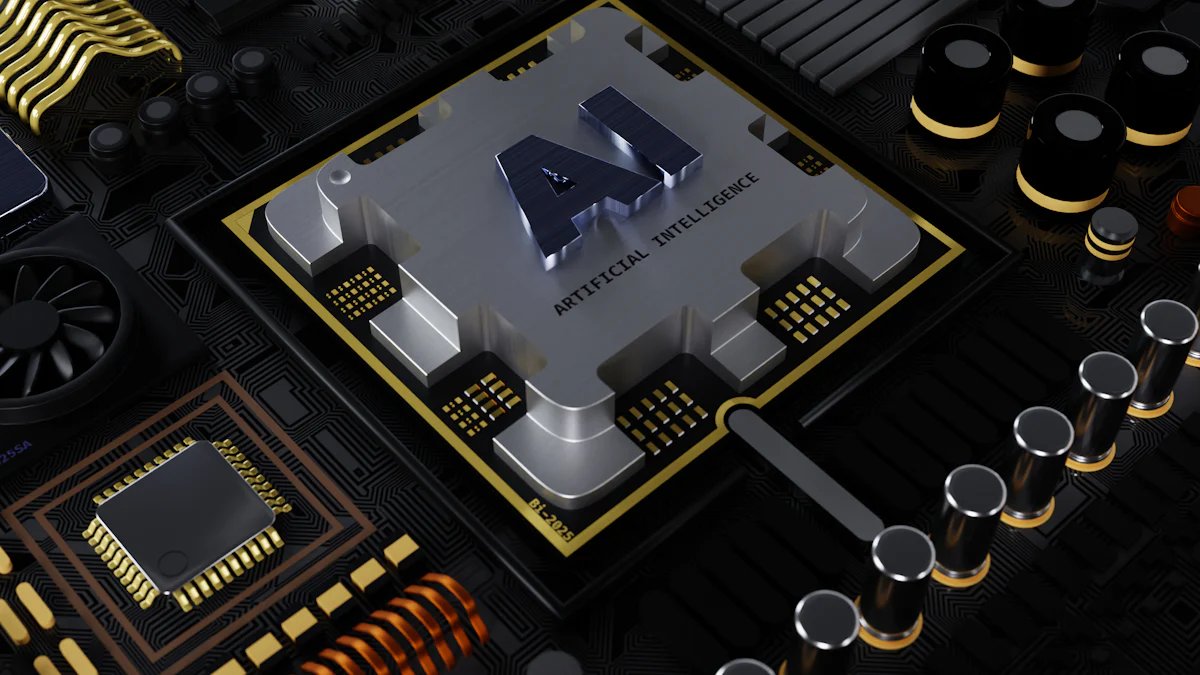The Role of Generative AI in Curriculum Design

Generative AI is transforming how you approach curriculum design. It involves using AI to create new content and ideas, enhancing educational experiences. Integrating AI in education proves crucial. A staggering 97% of students in higher education use AI-powered tools to boost their learning. Moreover, 62% of academic institutions plan to incorporate AI within two years. This integration not only personalizes learning but also increases graduation rates by 12%. As you explore these advancements, consider how AI can reshape curriculum design, making it more effective and engaging for students.
Understanding Generative AI
What is Generative AI?
Generative AI refers to artificial intelligence systems that can create new content. These systems use algorithms to generate text, images, music, and more. You might have encountered AI-generated art or music. These are examples of generative AI at work.
Key characteristics
Generative AI has several defining features:
Creativity: It can produce original content by learning from existing data.
Adaptability: It adjusts to new information and refines its outputs.
Efficiency: It generates content quickly, saving you time and effort.
Examples of generative AI applications
You can find generative AI in various fields:
Art and Design: AI creates unique artworks and designs.
Writing: It assists in drafting articles, stories, and reports.
Education: AI develops personalized learning materials for students.
How Generative AI Works
Generative AI relies on complex processes to function effectively. Understanding these processes helps you appreciate its capabilities.
Machine learning and neural networks
Machine learning forms the backbone of generative AI. It involves training algorithms to recognize patterns in data. Neural networks, which mimic the human brain, play a crucial role. They process information and make decisions based on learned patterns.
Data-driven content creation
Generative AI uses vast amounts of data to create content. It analyzes this data to identify trends and generate relevant outputs. For example, an AI system might study thousands of essays to write a new one. This data-driven approach ensures that the content is accurate and engaging.
By understanding these aspects of generative AI, you can better appreciate its potential in curriculum design. It offers innovative ways to enhance educational experiences and personalize learning for students.
The Evolution of Curriculum Design
Traditional Curriculum Design
Historical context
In the past, curriculum design followed a structured and uniform approach. Educators focused on delivering content through lectures and textbooks. This method aimed to provide a standardized education for all students. You might recognize this as the traditional classroom setting, where teachers led and students followed. The primary goal was to ensure that everyone received the same information.
Limitations and challenges
Traditional curriculum design faced several challenges. It often lacked flexibility and failed to address individual learning needs. Students with different learning styles struggled to keep up. The one-size-fits-all approach did not accommodate diverse backgrounds or interests. As a result, many students found it difficult to engage with the material. Teachers also faced challenges in adapting lessons to suit varying abilities.
Modern Approaches to Curriculum Design
Incorporating technology
Today, technology plays a crucial role in curriculum design. You can use digital tools to create interactive and engaging lessons. These tools allow you to present information in various formats, such as videos, simulations, and games. Technology enables you to reach students with different learning preferences. It also provides opportunities for real-time feedback and assessment. By incorporating technology, you can make learning more dynamic and accessible.
Personalized learning experiences
Modern curriculum design emphasizes personalized learning. This approach tailors educational experiences to meet individual needs. You can use data to understand each student's strengths and weaknesses. With this information, you can create customized learning paths. Personalized learning encourages students to take ownership of their education. It fosters a sense of autonomy and motivation. By focusing on individual needs, you can help students achieve their full potential.
"Investigating History Curriculum Design" aims to provide high-quality instructional materials. It supports teachers and students through inquiry-based, culturally responsive instruction. This approach reflects the shift towards modern curriculum design, where personalization and inclusivity are key.
Integrating Generative AI into Curriculum Design

Generative AI is reshaping curriculum design by offering innovative solutions that enhance educational experiences. As you explore its integration, consider the potential benefits and challenges it presents.
Potential Benefits
Enhanced creativity and innovation
Generative AI can significantly boost creativity in curriculum design. It generates new ideas and content, allowing you to create engaging and diverse educational materials. For instance, AI can help you develop interactive simulations or virtual reality experiences that captivate students' attention. By leveraging AI's creative capabilities, you can introduce novel teaching methods that inspire both educators and learners.
Personalized learning paths
One of the most significant advantages of generative AI is its ability to personalize learning experiences. AI systems analyze student data to identify individual learning patterns. This analysis enables you to tailor educational content to meet each student's unique needs. Personalized learning paths increase student engagement and improve learning outcomes. By adapting the curriculum to suit different learning styles, you can ensure that every student receives a tailored educational experience.
"AI-driven systems can analyze student data, identify individual learning patterns, and adapt the content and delivery accordingly. This personalized approach can lead to increased engagement, improved learning outcomes, and a more tailored educational experience for each student."
Challenges and Considerations
Ethical concerns
While generative AI offers numerous benefits, it also raises ethical concerns. You must consider the implications of using AI in education. Questions about bias in AI algorithms and the potential for AI to replace human educators are prevalent. It's crucial to address these concerns by ensuring that AI complements rather than replaces the human elements of teaching. Maintaining a balance between AI and human input is essential for fostering meaningful educational experiences.
"AI cannot successfully replicate the vital human elements of teaching, such as fostering meaningful relationships and providing emotional support."
Data privacy and security
Data privacy and security are critical considerations when integrating generative AI into curriculum design. AI systems rely on vast amounts of data to function effectively. You must ensure that student data is protected and used responsibly. Implementing robust data protection measures and adhering to privacy regulations is vital. By prioritizing data security, you can build trust with students and parents, ensuring that AI enhances education without compromising privacy.
As you navigate the integration of generative AI into curriculum design, it's essential to weigh the benefits against the challenges. By understanding the capabilities and limitations of this technology, you can make informed decisions that enhance the quality and effectiveness of modern education.
Case Studies and Examples
Successful Implementations
Schools and Universities
In recent years, many schools and universities have successfully integrated generative AI into their curriculum design. These institutions have witnessed remarkable improvements in student learning outcomes. For instance, AI-based tutoring systems have enhanced educational achievements by 24%. By using AI to create adaptive learning environments, universities have boosted learning efficiency by 19%, leading to increased graduation rates. You can see how AI helps identify student problems and assists teachers in providing targeted support. This approach not only personalizes learning but also ensures that students receive the necessary guidance to succeed.
Corporate Training Programs
Corporate training programs have also embraced generative AI to enhance employee learning experiences. Companies use AI-driven teaching programs to tailor training materials to individual needs. This personalization results in a 24% improvement in educational achievements among employees. By leveraging AI, organizations can create adaptive learning environments that boost learning efficiency. Employees benefit from customized training paths that align with their roles and responsibilities. As a result, companies experience increased productivity and employee satisfaction.
Lessons Learned
Best Practices
When integrating generative AI into curriculum design, you should consider several best practices. First, ensure that AI complements human educators rather than replacing them. This balance maintains the vital human elements of teaching, such as fostering relationships and providing emotional support. Second, prioritize data privacy and security. Protect student data by implementing robust security measures and adhering to privacy regulations. Third, continuously evaluate and refine AI systems to address any biases or inaccuracies. By following these best practices, you can maximize the benefits of AI in education.
Common Pitfalls
Despite the advantages of generative AI, there are common pitfalls to avoid. One major challenge is over-reliance on AI, which can lead to a loss of the human touch in education. You should ensure that AI serves as a co-intelligent partner, enhancing rather than replacing traditional teaching methods. Another pitfall is neglecting data privacy and security. Failing to protect student data can erode trust and compromise the effectiveness of AI integration. By being aware of these pitfalls, you can make informed decisions that enhance the quality of education while safeguarding student interests.
The Future of Curriculum Design with AI

As you look to the future, Generative AI promises to revolutionize curriculum design. This technology introduces new trends and long-term implications that will shape education.
Emerging Trends
AI-driven assessment tools
AI-driven assessment tools are transforming how you evaluate student performance. These tools provide real-time feedback, allowing you to identify areas where students excel or need improvement. By analyzing data, AI can offer insights into student progress, helping you tailor instruction to meet individual needs. This approach enhances learning outcomes and ensures that students receive the support they need to succeed.
Adaptive learning technologies
Adaptive learning technologies use AI to create personalized learning experiences. These systems adjust content based on each student's learning pace and style. For example, an AI-powered adaptive learning program can improve test scores by 62% compared to traditional methods. By using these technologies, you can ensure that students engage with material that matches their abilities and interests, leading to better retention and understanding.
Long-term Implications
Impact on educators
Generative AI will significantly impact educators. It offers tools that streamline lesson planning and content creation, freeing up time for you to focus on teaching. However, it's essential to maintain a balance between AI and human input. While AI can enhance educational experiences, the human touch remains crucial for fostering relationships and providing emotional support. As an educator, you must adapt to these changes and embrace AI as a co-intelligent partner in the classroom.
Student engagement and outcomes
The integration of AI in curriculum design will boost student engagement and outcomes. AI technologies have been shown to enhance retention rates by up to 30% compared to traditional methods. By offering personalized learning paths and interactive content, AI keeps students motivated and invested in their education. As a result, you can expect improved academic achievements and higher graduation rates. Embracing AI in education will help you create a more dynamic and effective learning environment for students.
By understanding these emerging trends and long-term implications, you can prepare for the future of curriculum design with AI. This technology offers exciting opportunities to enhance education and improve student outcomes. As you explore these possibilities, consider how AI can complement your teaching methods and enrich the learning experience.
Addressing Concerns and Misconceptions
Common Misunderstandings
AI replacing teachers
Many people worry that AI might replace teachers. This concern arises because AI can automate tasks and provide personalized learning experiences. However, AI cannot replicate the vital human elements of teaching. Teachers play a crucial role in fostering relationships and providing emotional support. AI serves as a tool to enhance teaching, not replace it. You should view AI as a partner that assists in delivering education more effectively.
Loss of human touch in education
Another common misconception is that AI will lead to a loss of the human touch in education. While AI can analyze data and offer insights, it lacks the ability to connect with students on a personal level. Human educators bring empathy, understanding, and creativity to the classroom. These qualities are essential for creating a supportive learning environment. By integrating AI thoughtfully, you can maintain the human touch while benefiting from technological advancements.
Addressing Concerns
Balancing AI and human input
Balancing AI and human input is essential for successful integration. You should use AI to complement your teaching methods, not replace them. AI can handle repetitive tasks, allowing you to focus on engaging with students. By combining AI's analytical capabilities with your expertise, you can create a more dynamic and effective learning experience. This balance ensures that students receive both personalized instruction and the human interaction they need to thrive.
Ensuring ethical AI use
Ensuring ethical AI use is crucial in education. You must address concerns about data privacy and algorithmic bias. AI systems rely on data to function, so protecting student information is vital. Implement robust security measures and adhere to privacy regulations. Additionally, be aware of potential biases in AI algorithms. Collaborate with technology providers to refine AI systems and ensure they promote fairness and inclusivity. By prioritizing ethical AI use, you can build trust and create a positive impact on education.
"Ethical implications, potential biases in algorithms, and the essential role of human educators must remain at the forefront as we embrace AI's potential to revolutionize higher education."
By addressing these concerns and misconceptions, you can harness the power of AI while preserving the essential human elements of education. This approach allows you to create a balanced and effective learning environment that benefits both educators and students.
Practical Steps for Educators
Getting Started with AI
Resources and tools
To begin your journey with AI in education, explore the vast array of resources and tools available. Many educational companies and institutions offer AI-powered tools designed to enhance learning experiences. These tools can help you with tasks like lesson planning, research, and student engagement. For instance, half of educators already use AI to assist with lesson preparations. By incorporating these tools, you can optimize your teaching methods and better meet student needs.
Consider starting with user-friendly platforms that provide AI-driven solutions tailored for educators. These platforms often include features like automated grading, personalized learning paths, and interactive content creation. As the AI education market is predicted to surpass 20 billion USD by 2027, staying informed about the latest tools will keep you ahead in the evolving educational landscape.
Training and professional development
Training and professional development are crucial for effectively integrating AI into your teaching practice. Many institutions offer workshops and courses focused on AI in education. These programs provide valuable insights into how AI can transform curriculum design and delivery. By participating in such training, you can gain the skills needed to leverage AI tools effectively.
Additionally, online resources and communities can support your learning journey. Engage with fellow educators who are also exploring AI integration. Sharing experiences and best practices can enhance your understanding and application of AI in the classroom. Continuous professional development ensures that you remain adaptable and prepared for future advancements in educational technology.
Collaborating with AI Experts
Building partnerships
Building partnerships with AI experts can significantly enhance your ability to integrate AI into curriculum design. Collaborate with technology providers and researchers who specialize in AI applications for education. These partnerships can offer valuable insights and support as you navigate the complexities of AI integration.
Engage with local universities or educational technology companies that focus on AI research. By working together, you can develop innovative solutions that address specific educational challenges. Partnerships with AI experts enable you to access cutting-edge technologies and stay informed about emerging trends in the field.
Leveraging expertise
Leveraging the expertise of AI professionals can help you maximize the benefits of AI in education. These experts can guide you in selecting the right tools and strategies for your teaching context. They can also assist in customizing AI solutions to meet the unique needs of your students.
Consider inviting AI specialists to conduct workshops or seminars for your educational community. These sessions can provide valuable knowledge and practical tips for integrating AI into your curriculum. By tapping into the expertise of AI professionals, you can ensure that your approach to AI in education is both effective and ethical.
"AI-powered tools and technologies can revolutionize the way curriculum is designed, delivered, and adapted." Embracing these practical steps will empower you to harness the full potential of AI, creating a more dynamic and engaging learning environment for your students.
Generative AI plays a pivotal role in transforming curriculum design. It offers adaptive learning environments and personalized paths, enhancing both teaching and learning experiences. As you look to the future, AI-powered technologies promise to reshape education by providing equal opportunities and improving learning outcomes. Embrace these advancements to create engaging and effective educational experiences. Explore AI integration in your teaching methods. By doing so, you can unlock new possibilities for student engagement and success.
See Also
The Impact of Generative AI on Creating Educational Content
Generative AI's Influence on Language Learning
Enhancing Student Learning with AI-Powered Tutoring
